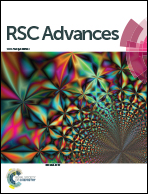Effect of Bi2O3 content on the microstructure and electrical properties of SrBi2Nb2O9 piezoelectric ceramics
Abstract
Lead-free ceramics, SrBi2Nb2O9–xBi2O3 (SBN–xBi), with different Bi contents of which the molar ratio, n(Sr) : n(Bi) : n(Nb), is 1 : 2(1 + x/2) : 2 (x = −0.05, 0.0, 0.05, 0.10), were prepared by conventional solid-state reaction method. The effect of excess bismuth on the crystal structure, microstructure and electrical properties of the ceramics were investigated. A layered perovskite structure without any detectable secondary phase and plate-like morphologies of the grains were clearly observed in all samples. The value of the activation energy suggested that the defects in samples could be related to oxygen vacancies. Excellent electrical properties (e.g., d33 = 18 pC N−1, 2Pr = 17.8 μC cm−2, ρrd = 96.4% and Tc = 420 °C) were simultaneously obtained in the ceramic where x = 0.05. Thermal annealing studies indicated the SBN–xBi ceramics system possessed stable piezoelectric properties, demonstrating that the samples could be promising candidates for high-temperature applications.



 Please wait while we load your content...
Please wait while we load your content...